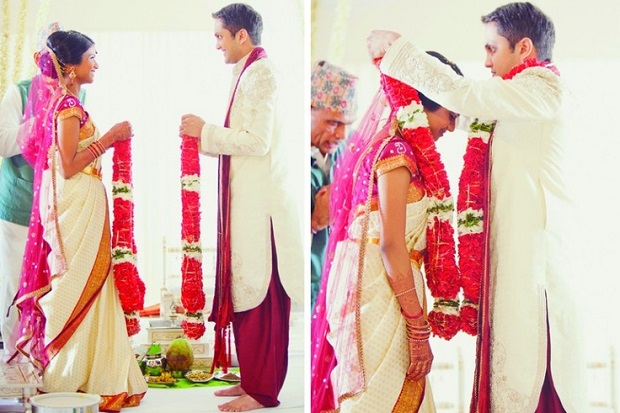Delicious food, beautiful clothes, boisterous, loud family and unlimited fun is what defines the Indian wedding best. Small, important rituals make the marriage more meaningful. One of the most important rituals is that of exchanging varmala or garland in simple English. Garlands in Indian weddings have an interesting history behind it. Read the following post to know more.
No Indian marriage is considered complete till the bride and groom exchange heavily weaved jaimala of flowers together. There are a lot of stories in Hindu mythology that explains the significance behind the whole ritual. Here are some unheard stories behind the ritual of garland exchange.
What is a Varmala?
The word varmala means the garland for the groom. It ancient times, it was considered as the acceptance of marriage proposal by the bride and groom. The ritual finds its roots in various ancient scriptures and texts. Even in Gandharva Vivahs, marriage of celestial beings, the marriage was sealed by exchange of garlands.
The vibrantly coloured jaimalas are made up of sweet-smelling, freshly bloomed flowers. They are made of bright flowers so that the visual impact of it is lasting on people’s minds. Though it is very difficult to string together the garland, people still prefer it for its looks and fragrance.
image via indianroots.com
Usually, it is rose or jasmine that is used to make it along with small, shiny adornments. The fragrance of rose and beauty of jasmine keeps garland in Indian wedding intact and beautiful – looking even after it is stored for a few hours. These days, people also opt for artificial varmalas. They are usually made of fabric, net, foil, small embellishments and decorative pieces. They are gaining popularity these days because they are easy to handle, do not get ruined or spoiled easily and are a more viable option than a real flower garland.
Use of Varmala in the Past
In the past, a girl used to choose her groom by putting a garland around his neck in a ceremony called Swayamwar. A mention of this is made in many old scriptures and epics, the noted one being Ramayana. In Ramayana, Sita had put a garland around Lord Ram’s neck after he breaks the bow which is a symbol of her accepting him as her husband.
Like Ramayana, in Mahabharata also Draupadi’s swayamwar is explained in details. As with Sita, Drapuadi had to choose a husband for herself from a large number of prospective grooms who had gathered together. At the end, she chose Arjun to be her husband by garlanding him. Another interesting story is of Samyukta, daughter of Jaichandra, king of Kanauj and Prithvi Raj where the Swayamvar ceremony is held with much pomp and pleasure.
Varmala – Present Day Use and Practices
Varmala, till date, still has this kind of importance in Indian weddings. In each part of the country, in every religion, the ritual exists; even though it might be followed in some different sequence or manner. Usually, the couple, first the bride and then the groom, exchanges the garland once they meet for the first time and then the other marriage rituals are carried on. The ceremony is carried on with a lot of teasing and fun on part of the family and friends. The ceremony is not just about exchanging floral garlands but symbolizes their love and respect for each other. A common standing joke is that the one who gives in first and garlands the other person will always listen to the other person throughout their married life.
These garlands can easily burn a huge hole in your pockets. They might be good to look at but come at a huge price and are difficult to carry as well. Sometimes, people prefer making it themselves by following the easily available online tutorial videos. It requires a lot of patience and skills to just sit and keep stringing the flowers together. The other option available these days is of artificial garlands. These are made up of all artificial material and are much easier to work on than natural garlands. They are more viable to make because there is no chance of them getting spoiled and can even be made easily at home.
Indian weddings are known for their traditions and customs. With certain set rituals is what them so much of fun and beautiful. Each and every ceremony holds its own significance. Same is the case with garlands for Indian weddings or jaimalas. They hold their own special place and importance in Hindu weddings. Anything good that happens is celebrated with flowers. So is the practice of wedding rituals.
Author Bio-Sampurna Majumder is a digital media professional, who loves creativity and challenges. Passionate about blogging and writing, she writes about a lot many things that cross her way. She has been lending her expertise to the online world by writing about a wide range of topics spanning from career, education, jobs and even relationships.
Featured image: DKreate Photography

